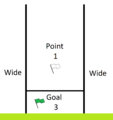Hurling facts for kids
Hurling is an exciting outdoor team sport from Ireland. It's a bit like hockey, but with its own unique rules! Two teams of 15 players compete to score points.
Players use a special wooden stick called a hurley (or camán in Irish). They hit a small ball, called a sliotar, towards the other team's goal. You score points by hitting the sliotar between the goalposts. If it goes over the crossbar, it's one point. If it goes under the crossbar into the net, it's a goal, which is worth three points! A goalkeeper tries to stop the ball from going into the net.
Players can catch the sliotar in their hand, but only for four steps. They can also hit it in the air or on the ground with the hurley. For short passes, players can kick the ball or slap it with an open hand. If a player wants to carry the ball for more than three steps, they must bounce or balance it on the end of their hurley. They can only handle the ball twice while they have it.
Contents
How Hurling is Played
The Players and Equipment
A hurling team has 15 players, often called "hurlers." Each player uses a hurley, which is a wooden stick. These sticks are usually about 70 to 100 cm (32 to 36 inches) long. The goalkeeper's hurley is a bit different. It has a wider, flatter end called a bás. This helps them stop the fast-moving sliotar.
The sliotar is the ball used in hurling. It has a cork center and a leather cover. It's about 23 to 25 cm around and weighs between 100 and 130 grams. Hurlers can hit the sliotar incredibly fast! A good hit can send the ball flying up to 150 km/h (93 mph) and travel over 100 meters (305 feet).
Scoring Points in Hurling
Scoring is simple but exciting!
- If the sliotar goes over the crossbar and between the posts, your team gets one point.
- If the sliotar goes under the crossbar and into the net, your team scores a goal. A goal is worth three points.
The team with the most points at the end of the game wins!
The Hurling Pitch
Hurling is played on a large grass field. It's usually about 137 meters (450 feet) long and 82 meters (270 feet) wide. At each end of the field, there are goalposts. These posts are usually 6 meters (20 feet) high and are set 6.4 meters (21 feet) apart. A crossbar connects them 2.44 meters (8 feet) above the ground. A net hangs behind the crossbar and lower posts, just like in soccer, to catch goals.
Other Pages You Might Like
Images for kids
-
A hurling stick and ball feature on this gallowglasses gravestone, circa 15–16th century.
-
U.S. president Barack Obama accepting a hurley from Taoiseach Enda Kenny
See also
 In Spanish: Hurling para niños
In Spanish: Hurling para niños













